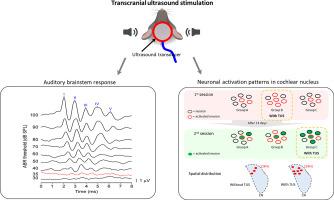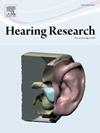经颅超声对听觉脑干反应及耳蜗核神经元活化的影响
IF 2.5
2区 医学
Q1 AUDIOLOGY & SPEECH-LANGUAGE PATHOLOGY
引用次数: 0
摘要
目的颅超声刺激(us)是一种具有治疗神经退行性疾病潜力的无创技术。鉴于其日益增加的治疗相关性,识别任何意想不到的后果是至关重要的,特别是在听觉通路等脆弱系统上。具体来说,TUS对听觉反应和中枢听觉系统内神经激活模式的确切影响尚不清楚。我们假设TUS可以间接调节中枢听觉加工,甚至在直接听觉范围之外的频率,导致听觉脑干反应(ABRs)和耳蜗核神经元活动的可观察变化。我们分析了1 MHz超声刺激前后小鼠周期性ABR记录。为了研究超声刺激对耳蜗核的即时和长期印迹效应,我们使用c-Fos TRAP2小鼠。所有小鼠均接受12 kHz的纯音刺激,以建立耳蜗核的音调特征。我们在第一次音调呈现前(超声预处理组)或牺牲前30分钟(急性超声组)对整个大脑进行超声刺激,覆盖包括耳蜗核在内的区域,分别分析超声刺激的长期和即时反应。假对照组只接受12千赫的音调刺激。结果超声刺激可引起ABR记录的潜伏期偏移。超声对潜伏期的影响在远离内耳的听觉通路区域更为明显。急性超声组的即时神经激活显著增加,超声预处理组的长期印痕效应有增加的趋势。在超声心动图后,在耳蜗核中一致发现了更宽的神经激活带。这些结果表明,TUS可以影响耳蜗核的神经激活,表现为ABR潜伏期移位。结论超声刺激可引起ABR记录的潜伏期移位,改变耳蜗核内神经元的激活模式,提示超声对听觉通路具有调节作用。超声观察到的沿听通路神经元的激活可能为改善中枢性听通路功能障碍(如听神经病变)患者的听转导提供治疗机会。本文章由计算机程序翻译,如有差异,请以英文原文为准。

The impact of transcranial ultrasound on auditory brainstem responses and neuronal activation in the cochlear nucleus
Objectives
Transcranial ultrasound stimulation (TUS) is a non-invasive technique with therapeutic potential for neurodegenerative diseases. Given its increasing therapeutic relevance, it is essential to identify any unintended consequences, especially on vulnerable systems such as the auditory pathway. Specifically, the precise impact of TUS on auditory responses and neural activation patterns within the central auditory system remains unclear. We hypothesized that TUS could indirectly modulate central auditory processing, even at frequencies outside the direct hearing range, leading to observable changes in auditory brainstem responses (ABRs) and neuronal activity in the cochlear nucleus.
Design
We analyzed periodic ABR recordings before and after 1 MHz ultrasound stimulation in mice. To investigate the immediate and long-term engram effects of ultrasound stimulation in the cochlear nucleus, we used c-Fos TRAP2 mice. All mice received a 12 kHz pure tone stimulation to establish the tonal signature in the cochlear nucleus. We administered ultrasound stimulation transcranially over the entire brain, covering the region including the cochlear nucleus, either immediately prior to the first tone presentation (ultrasound preconditioning group) or 30 minutes prior to sacrifice (acute ultrasound group) to analyze the long-term and immediate responses to ultrasound stimulation, respectively. A sham control group received only the 12 kHz tone stimulation.
Results
Ultrasound stimulation induced latency shifts in ABR recordings. The effect of ultrasound on latency was more pronounced at regions of the auditory pathway farther from the inner ear. A significant increase in immediate neural activation was observed in the acute ultrasound group, while a trend toward an increase in long-term engram effect was seen in the ultrasound preconditioning group. A broader band pattern of neural activation was consistently identified in the cochlear nucleus following TUS. These results suggest that TUS can affect neural activation in the cochlear nucleus, manifesting as ABR latency shifts.
Conclusions
This study provides evidence that ultrasound stimulation can induce latency shifts in ABR recordings and alter neuronal activation patterns in the cochlear nucleus, indicating a modulatory effect of ultrasound on the auditory pathway. The observed activation of neurons along the auditory pathway by ultrasound may offer therapeutic opportunities to improve auditory transduction in patients with central auditory pathway dysfunction, such as auditory neuropathy.
求助全文
通过发布文献求助,成功后即可免费获取论文全文。
去求助
来源期刊

Hearing Research
医学-耳鼻喉科学
CiteScore
5.30
自引率
14.30%
发文量
163
审稿时长
75 days
期刊介绍:
The aim of the journal is to provide a forum for papers concerned with basic peripheral and central auditory mechanisms. Emphasis is on experimental and clinical studies, but theoretical and methodological papers will also be considered. The journal publishes original research papers, review and mini- review articles, rapid communications, method/protocol and perspective articles.
Papers submitted should deal with auditory anatomy, physiology, psychophysics, imaging, modeling and behavioural studies in animals and humans, as well as hearing aids and cochlear implants. Papers dealing with the vestibular system are also considered for publication. Papers on comparative aspects of hearing and on effects of drugs and environmental contaminants on hearing function will also be considered. Clinical papers will be accepted when they contribute to the understanding of normal and pathological hearing functions.
 求助内容:
求助内容: 应助结果提醒方式:
应助结果提醒方式:


